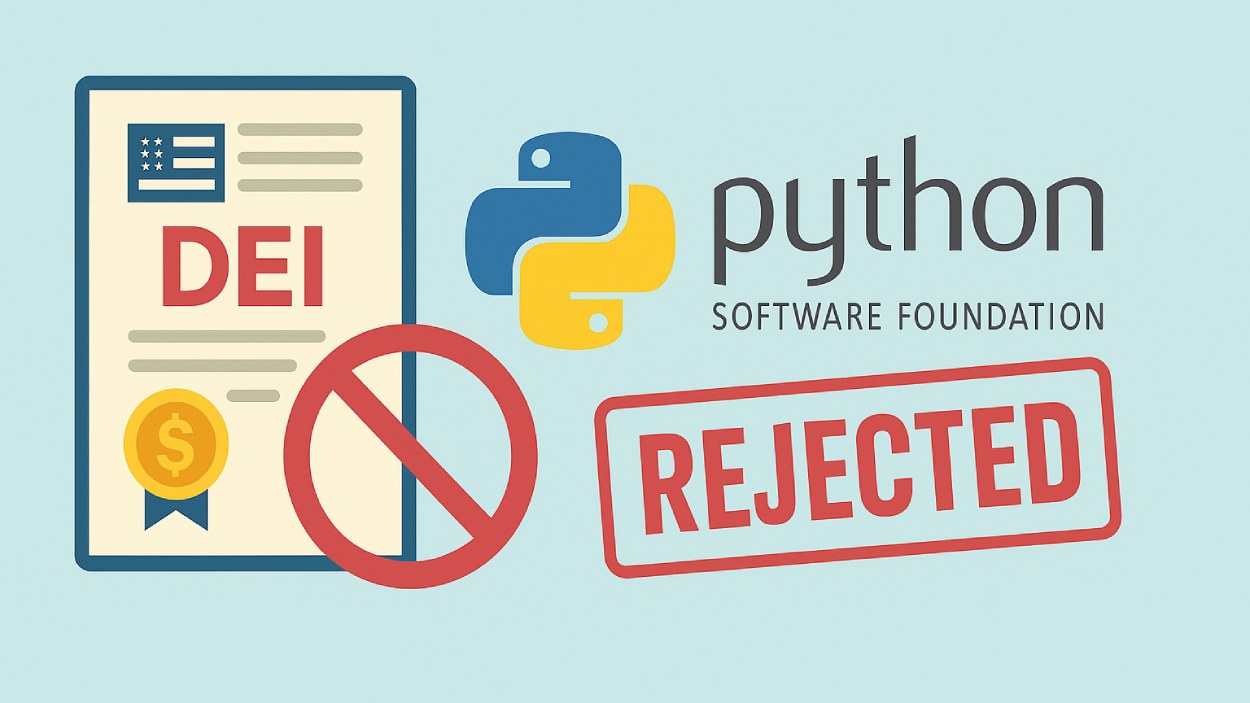Stripe, the payments infrastructure powerhouse, has seen its workforce shift significantly over the past few years. Its headcount reflects not just internal strategy, but broader cycles in fintech hiring, investor expectations, and operational scaling. In real-world terms, a mid‑sized SaaS company benchmarking Stripe’s growth trajectory might model its hiring plan around Stripe’s headcount curves, or investors assessing fintech valuations often correlate valuation multiples with employee growth rates. In this article, we dive into the numbers, from past trends to future projections, to understand how many people work at Stripe, and why it matters.
How Many People Work At Stripe?
- Stripe is targeting a workforce of 10,000 employees by the end of 2025, up from ~8,200 before recent cuts.
- In early 2025, Stripe cut 300 jobs, equating to ~3.5% of its workforce.
- Before the 2025 layoff, its headcount was estimated at ~8,500 employees.
- Some sources report Stripe’s 2025 headcount to be around 8,550.
- In 2025, roughly 40% of employees are engineers, about 3,400 of ~8,570.
- In November 2022, Stripe cut 14% of its workforce, ~1,120 employees.
- Stripe’s headcount was ~8,017 (2025 figure) with 1,117 new hires and 558 departures YTD.
Recent Developments
- In January 2025, Stripe laid off 300 employees, ~3.5% of its workforce, mainly from product, engineering, and operations.
- Despite the layoffs, Stripe reaffirmed its aim to grow headcount by ~17%, targeting 10,000 employees in 2025.
- Before the cuts, Stripe’s workforce was estimated at ~8,500 employees.
- Stripe’s headcount was estimated at 8,550 employees before the layoffs, implying a post-layoff number around ~8,250.
- The layoffs reflect team-level reorganizations to “put people in the right roles” rather than pure headcount decline.
- Stripe’s dual headquarters in San Francisco and Dublin continue to expand operations, with cuts and growth applied across the global footprint.
- A “cartoon duck” was mistakenly included in one layoff notification, drawing public attention to internal communications.
- In previous cycles, Stripe has executed layoffs, such as in 2022, to recalibrate its cost structure during economic downturns.
Top Countries Using Stripe by Website Count
- United States leads with 715,735 Stripe-powered websites, showing massive dominance in global adoption.
- United Kingdom ranks second with 82,464 websites, driven by strong e-commerce and SaaS usage.
- France follows with 53,044 Stripe sites, reflecting deep integration into its digital economy.
- Germany counts 40,116 websites using Stripe, supported by a robust fintech infrastructure.
- Australia has 37,869 Stripe-enabled sites, highlighting strong APAC penetration.
- Canada records 26,388 websites, boosted by cross-border commerce growth.
- Italy and Spain host 22,779 and 19,060 websites, respectively, showing rising Southern European adoption.
- India reports 15,376 Stripe-powered sites, signaling fast growth in digital payments.
- Mexico closes the top 10 with 12,993 websites, underscoring expanding digital commerce in Latin America.
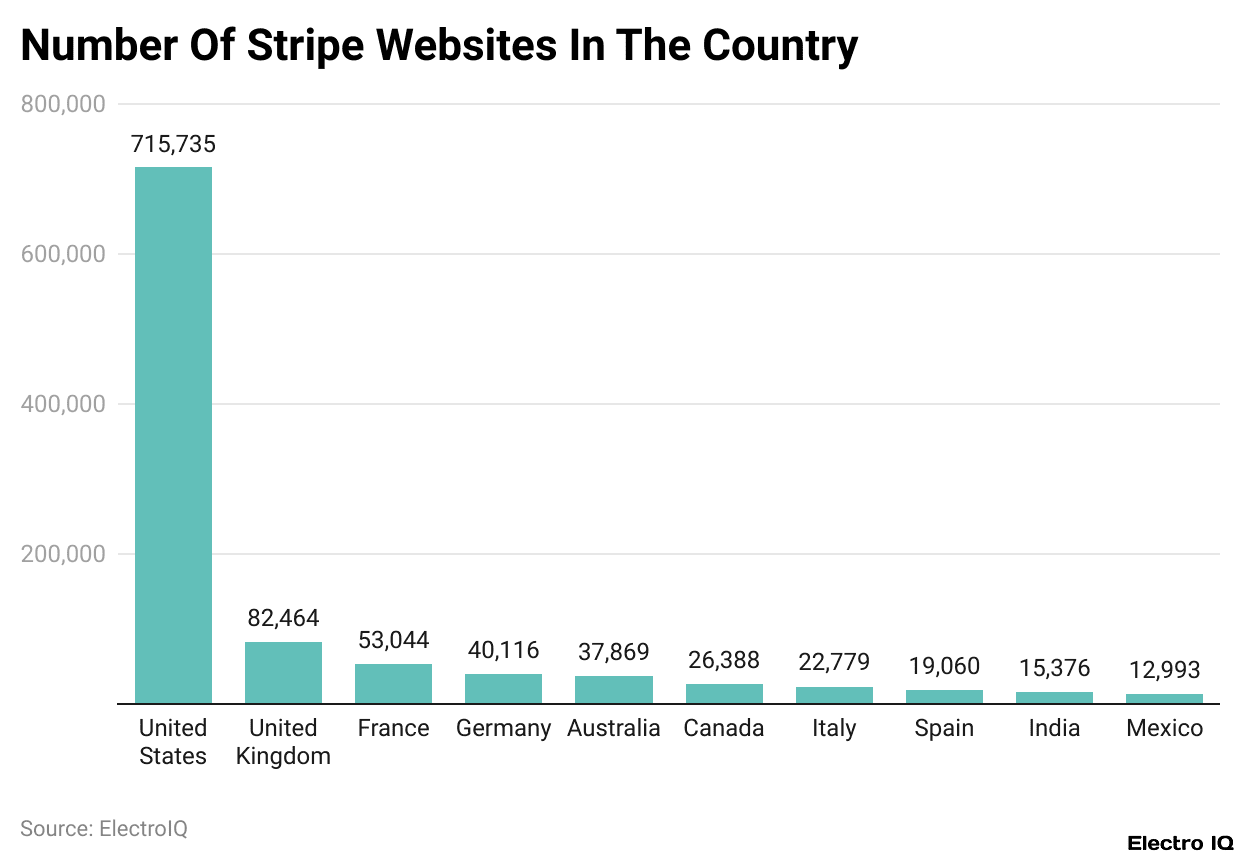
Stripe’s Current Team (Key People)
- Patrick Collison, Stripe’s co-founder and CEO, continues to lead the company with a focus on long-term product development and operational discipline.
- John Collison, co-founder and President, plays a key role in Stripe’s global expansion strategy and internal product alignment.
- David Singleton, CTO since 2018, oversees Stripe’s engineering division, which accounts for more than 40% of its workforce.
- Christa Davies joined Stripe’s board in 2024. She is also CFO at Aon and brings extensive financial oversight experience to Stripe’s leadership.
- Dhivya Suryadevara, Stripe’s CFO, formerly of General Motors and Instacart, manages Stripe’s financial strategy as it prepares for potential IPO or further secondary liquidity events.
- Trish Walsh, General Counsel, leads Stripe’s legal, regulatory, and compliance efforts across global markets.
- Claire Hughes Johnson, a former COO and longtime Stripe executive, continues to serve as a board member and advisor.
- Eileen O’Mara, Global Revenue & Growth Lead, manages Stripe’s sales, partnerships, and customer-facing growth teams.
- Mike Clayville, Chief Revenue Officer, previously with AWS, is responsible for aligning go-to-market strategy with product development.
- Will Gaybrick, Chief Product Officer, has been instrumental in launching major financial tools, including Stripe Treasury and Stripe Capital.
- Tom Karlo, Head of Engineering Operations, has scaled Stripe’s technical infrastructure and team frameworks.
- Stripe’s board includes external heavyweights like Mark Carney (former Bank of England governor) and Sir Michael Moritz (Sequoia Capital), adding regulatory and investor expertise.
Stripe Employee Count Overview
- Stripe’s employee count in 2025 is generally listed as ~8,500.
- Wikipedia notes “Num Employees: 8,500 (2025)” for Stripe.
- After removing 300 roles (3.5%), the headcount would be around ~8,200.
- Pre-layoff estimates ranged as high as 8,550, making the post-layoff estimate ~8,250.
- Other sources also list ~8,550 employees worldwide in 2025.
- Some databases similarly report 8,550 total employees.
- One platform estimated 8,017 employees, showing possible discrepancies due to timing or data-reporting delays.
- The working range for 2025 is ~8,000 to ~8,550.
Stripe Employee Distribution by Department
- Engineering leads with 3,378 employees, accounting for just over 40% of Stripe’s ~8,000 staff.
- Marketing & Product has about 1,093 employees.
- Sales & Support includes approximately 1,047 employees.
- Finance & Administration employs around 652 people.
- Business Management holds about 416 employees.
- Operations has roughly 394 team members.
- Human Resources includes about 320 employees.
- Information Technology comprises 248 employees.
- Risk, Safety, & Compliance has around 169 employees.
- Other departments collectively total around 300 employees.
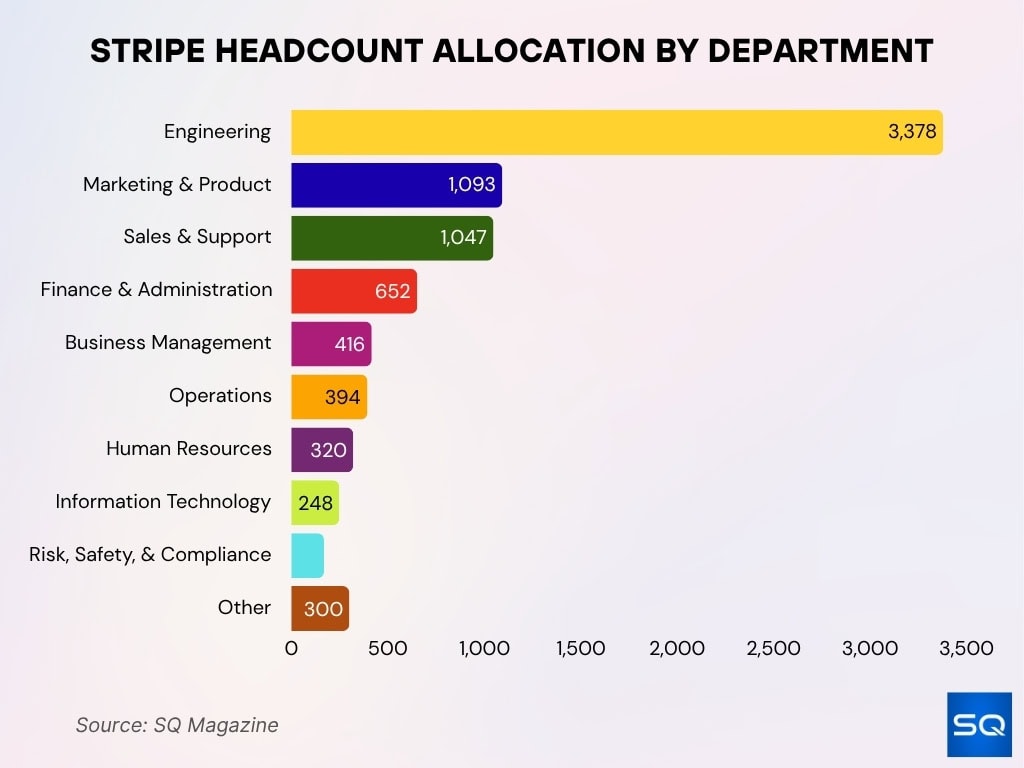
Historical Employee Numbers
- In 2022, Stripe cut ~1,120 employees, about 14% of its workforce at that time.
- Prior to that 2022 layoff, Stripe had an estimated ~8,000 employees.
- After the 2022 cuts, headcount likely dropped to ~7,000 or lower.
- By 2023 and 2024, Stripe’s workforce trended upward again, steadily passing 7,000.
- By late 2023, Stripe resumed hiring, adding new teams as fintech demand rebounded.
- Historically, Stripe’s growth has accelerated during funding cycles and decelerated during macroeconomic downturns.
- The 2022 layoff remains one of Stripe’s most significant structural resets.
- Historical figures before 2022 are limited in public reporting.
Workforce Changes and Layoffs
- In January 2025, Stripe cut 300 positions, about 3.5% of its workforce, largely in product, engineering, and operations.
- That followed a larger reduction in November 2022, when Stripe eliminated ~1,120 roles (~14%).
- The 2025 layoffs involved reorganization by team and location rather than mass downsizing.
- Despite cuts, Stripe plans to grow headcount by ~17% and reach 10,000 employees by year’s end.
- Stripe’s workforce before the January 2025 cuts was ~8,550.
- Some layoffs were intended to eliminate role overlaps and optimize Stripe’s cost structure.
- The company did not issue widespread WARN notices, suggesting that layoffs were selective.
- The layoffs were framed more as talent redeployment than retrenchment.
Most Valuable Unicorns in the World
- SpaceX leads with a $350 billion valuation, making it the most valuable private company globally.
- ByteDance is second at $300 billion, dominating the Media & Entertainment category.
- OpenAI ranks third with a $157 billion valuation, leading in Enterprise Tech.
- Stripe holds 4th place at $91.5 billion, topping Financial Services unicorns.
- SHEIN is valued at $66 billion, ranking highest in Consumer & Retail.
- Databricks and Anthropic are valued at $62 billion and $60 billion, respectively, both in Enterprise Tech.
- xAI follows with a $50 billion valuation, also in the Enterprise space.
- Revolut is worth $45 billion, second among fintech unicorns after Stripe.
- Canva rounds out the top 10 with a $32 billion valuation, representing design tech from Australia.
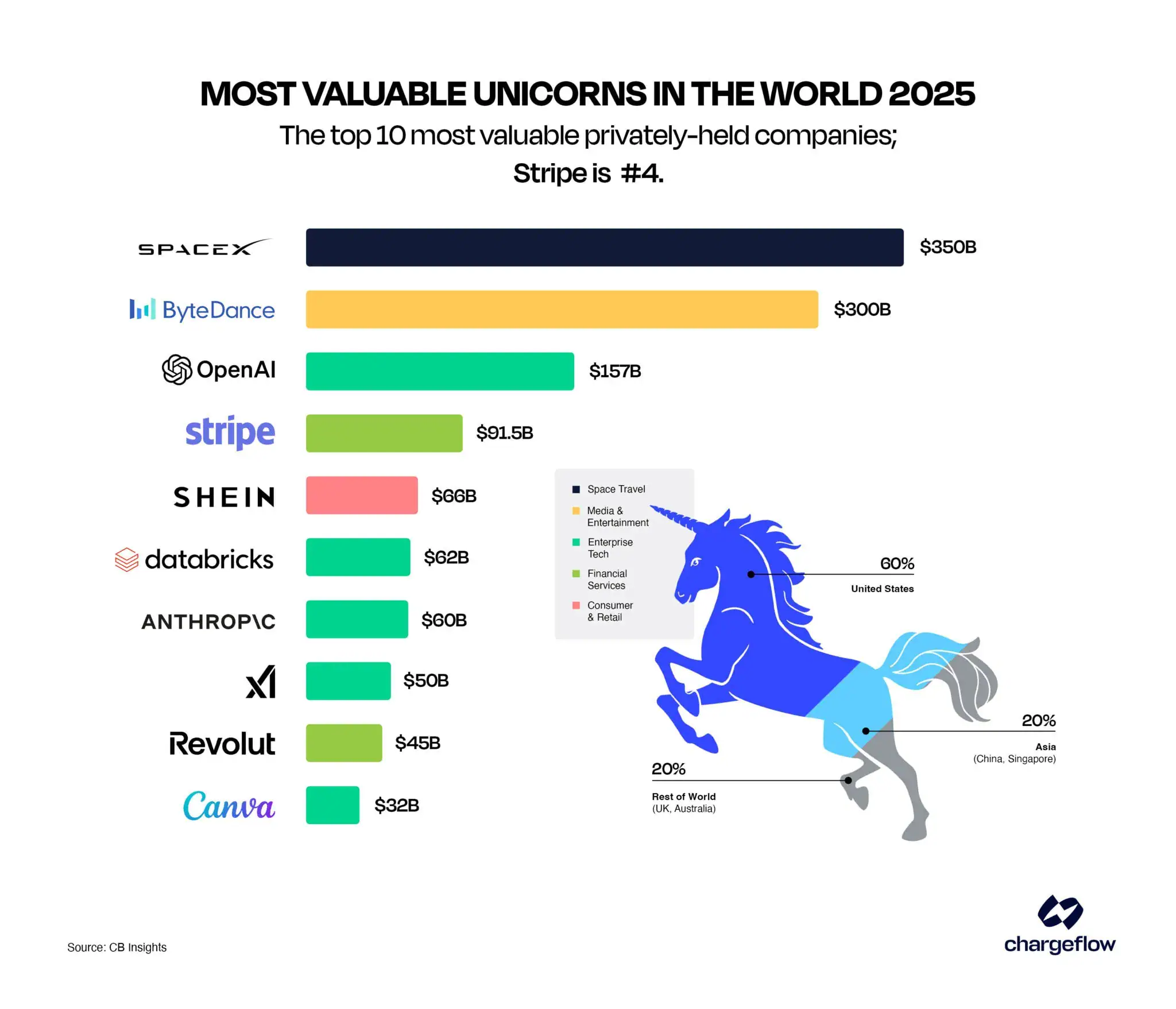
Projected Employee Numbers at Stripe
- Stripe projects ~10,000 employees by the end of 2025, a growth of about 17%.
- Starting from ~8,550, this implies adding ~1,450 net roles.
- After accounting for 300 layoffs, gross hires needed could exceed 1,700.
- Unify reports Stripe hired 1,117 and lost 558 in departures YTD, a net gain of 559.
- That equates to ~7.2% year-over-year growth.
- If hiring continues steadily, the 10,000 target is achievable.
- External conditions and execution quality will determine whether that target is exceeded or missed.
- Stripe’s growth model assumes both aggressive hiring and moderate attrition.
Stripe Headcount Growth Trends
- Total headcount was 8,017, up ~7.2% YoY.
- Engineering and GTM verticals have seen the highest growth.
- Stripe’s annual growth range of 5–10% seems steady under normal conditions.
- The company exhibits “grow, prune, realign” behavior, not constant expansion.
- Stripe’s model supports lean, high-impact teams over large headcount surges.
Stripe User Demographics by Gender and Age
- 61.42% of Stripe users are male and 38.58% are female, showing a clear gender gap.
- 32.02% of users are aged 25–34, the largest group of early-career pros and founders.
- 22.80% fall within the 18–24 bracket, reflecting strong usage among digital-native entrepreneurs.
- 19.64% are in the 35–44 range, typically mid-career operators and managers.
- 11.53% are aged 45–54, representing experienced professionals and business owners.
- 7.43% are within 55–64, likely involved in consulting or transitioning legacy businesses.
- 5.57% are aged 65+, showing growing interest among late-career users and retirees.
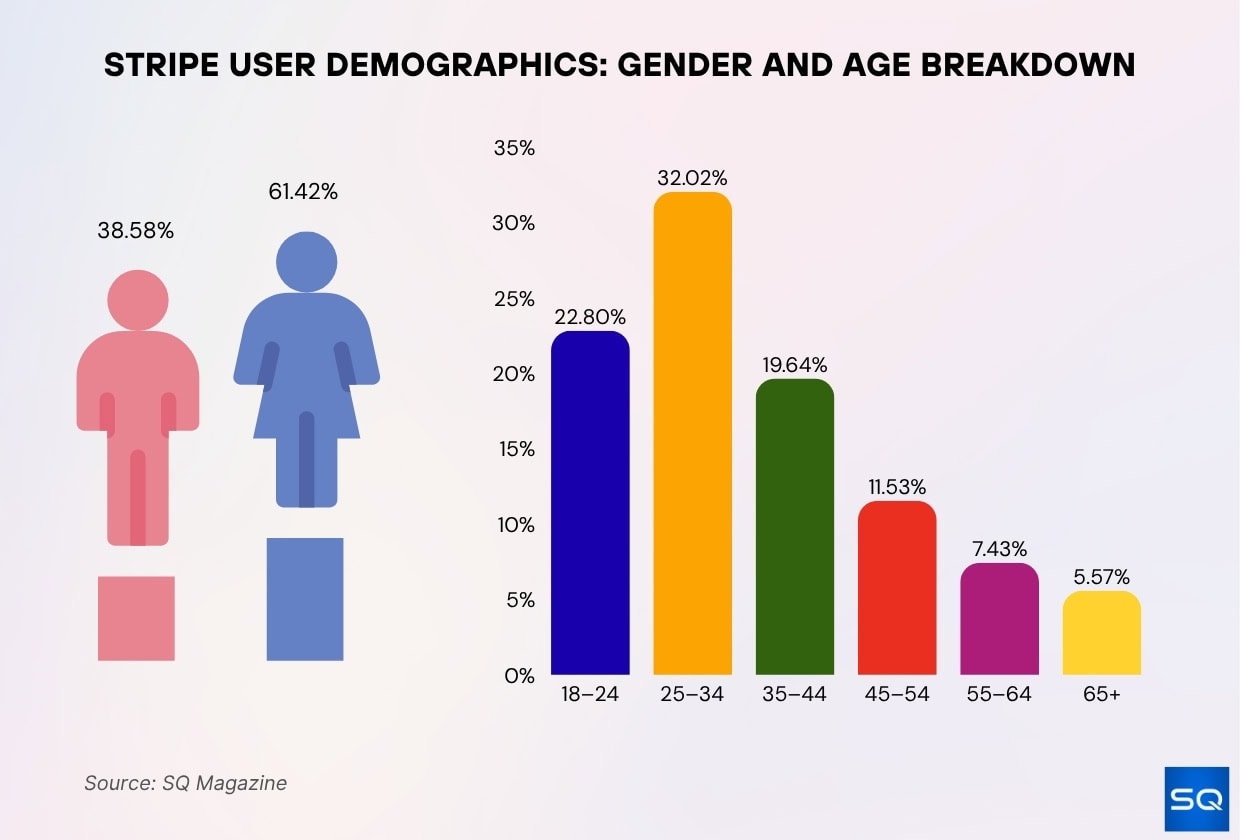
Geographic Distribution of Employees
- Stripe’s workforce spans 19 global locations.
- U.S. hubs: New York (~997), Seattle (~915), San Francisco (~687).
- International offices: Dublin (~329), Singapore (~253), Bengaluru (~229), London (~207).
- ~4,034 employees are in the “Other/remote” category.
- Stripe’s dual headquarters are in San Francisco and Dublin.
- The U.S. remains the company’s core base, but non-U.S. growth is visible.
- Remote roles provide flexibility across geographic boundaries.
- Distributed teams allow regulatory, talent, and operational diversification.
Recent Hiring and Attrition Statistics
- 1,117 new hires have joined Stripe YTD in 2025.
- 558 employees departed in the same period.
- Net growth = +559 employees, or ~7.2%.
- Engineering accounted for most new hires.
- Operational and support roles saw moderate hiring.
- Attrition appears stable and relatively low.
- The 2:1 hire-to-departure ratio shows strong expansion intent.
- If this pace continues, Stripe could meet or exceed its growth targets.
Stripe Workplace Demographics
- 43.7% of Stripe employees are male, and 56.3% are female.
- Racial distribution: ~49.3% Hispanic or Latino, ~36.8% White, ~9.4% Black or African American, ~2.6% Asian, ~1.9% unknown/other.
- Age distribution: ~46% are 20–30, 29% are 18–20, 14% are 30–40, 7% are 40+.
- Job tenure: 45% stay under 1 year, 31% stay 1–2 years, 11% stay 5–7 years, and fewer than 10% stay beyond 8 years.
- Education: ~47% hold a high school diploma, 15.9% hold an associate degree, and 15.5% have a bachelor’s.
- Most common majors: Business (~25.3%), followed by Criminal Justice (~10.7%).
- Demographic data is user-submitted and may not represent Stripe’s official internal metrics.
Comparison With Industry Competitors
- PayPal has ~24,400 employees as of 2024, down from 27,200 in 2023.
- This represents a ~10.3% YoY decrease.
- Adyen, a smaller peer, employs ~4,345 employees.
- Stripe’s employee base is about double that of Adyen, but still far smaller than PayPal’s.
- Stripe’s engineering-to-headcount ratio is higher than most competitors.
- Stripe’s model is more infrastructure and platform-focused, unlike PayPal’s consumer-heavy approach.
- Stripe maintains a leaner, more technical profile than legacy incumbents.
- The company is closer in structure to developer-first platforms than to full-stack financial services giants.
Frequently Asked Questions (FAQs)
Stripe reports 8,500 employees in 2025.
Stripe laid off 300 employees, about 3.5% of its workforce.
Stripe aims to reach 10,000 employees by the end of 2025, a roughly 17% increase over current levels.
Engineers make up about 40% of Stripe’s workforce, roughly 3,428 out of ~8,570 employees.
Conclusion
Stripe’s employee count is generally estimated in the 8,000 to 8,550 range, with public sources listing 8,500 employees. Its internal goal to reach 10,000 employees by year’s end shows continued hiring ambition despite periodic cuts.
Demographically, Stripe’s workforce leans younger, with a large share in the 20–30 age band, and higher reported female participation than many tech peers. Departmentally, more than 40% of its workforce is in engineering, and it maintains significant function-level investment in product, compliance, and operations. Compared to peers, Stripe operates on a more specialized scale than PayPal, but it outpaces many smaller fintechs in engineering ratio and growth ambition. The company faces the classic fintech balancing act, scaling talent while managing cost, retention, and regulatory load.











































